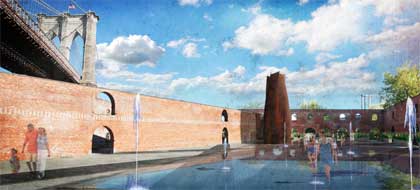
BBPCC rendering of proposed alternative use of Tobacco Warehouse open space
Brooklyn Bridge Park’s Tobacco Warehouse must remain a public, multi-use facility and maintain its current mix of indoor/outdoor space, says The Brooklyn Bridge Park Community Council in a report provided exclusively to BHB.
The BBPCC, a coalition of neighborhood groups and supporters of the park, states that, “the Tobacco Warehouse should remain a stabilized, architectural ruin, activated with enhancements that allow it to be a flexible, public, multipurpose outdoor space accommodating a wide variety of activities, and not dominated by one use or group.” It includes proposals for enhanced use of the space as well as a historical perspective from Francis Morrone.
Read the full document after the jump.
This report is in reaction to word that the Brooklyn Bridge Park Development Corporation is preparing to issue a Request for Proposal (RFP) to developers for renovation of the Warehouse into a cultural arts center.
Sources claim that DUMBO’s largest developer, Two Trees, has been floating a plan since Spring to convert the facility into a glass roofed, single use venue. They reportedly plan to house St. Ann’s Warehouse (soon to be displaced by their Dock Street project) and another arts group.
As for the landmark status of the Warehouse, the NYC LPC does not have jurisdiction over the building as it is in a New York State controlled park. The LPC could, however, write a letter stating its recommended course of action. The ultimate decision regarding to roof or not to roof would fall under New York’s State Historic Preservation Office. It could be a slippery slope for preservationists as Two Trees’ rumored plan proposes to glass roof the structure at its original 1860s height.
Roofing and narrowing its use would be in direct conflict with a list of 6 goals of the Tobacco Warehouse created by the BBPCC, based upon “25 years of community consensus”. It states:
1. OPENNESS maintain a roofless open space
2. HISTORY preserve the historic structure as “a stabilized ruin”
3. ECOLOGY create an environmentally sustainable space
4. REVENUE create the potential for generation of revenue for program and facility support
5. ACCESS provide year-round public access
6. USE FLEX allow use of the space for a large variety of things throughout the year
That’s before you get sucked into thinking that the “fix is in” for the Two Trees’ scenario to move forward. The BBPCC insists that the process needs to be public and transparent to insure that the Tobacco Warehouse remains part of the park and doesn’t fall into private domain.
The BBPCC supporter’s group as of today’s report includes:
the American Institute of Architects – Brooklyn Chapter
the American Institute of Architects – New York Chapter
the American Society of Landscape Architects – New York Chapter
the Atlantic Avenue LDC
the Boerum Hill Association
the Brooklyn Heights Association
Concord Village Owners
the DUMBO Neighborhood Alliance
the Fine Arts Federation
the Fulton Ferry Landing Association
JoAnne Simon, NYS Committeewoman, 52nd Assembly District
the Historic Districts Council
the Van Alen Institute
the Vinegar Hill Neighborhood Association
The report was prepared by NV/da and dlandstudio for the BBPCC.


